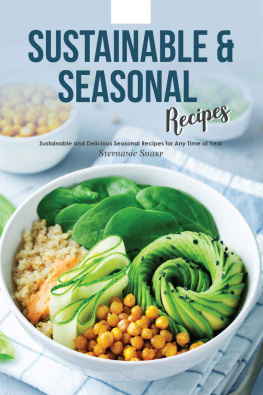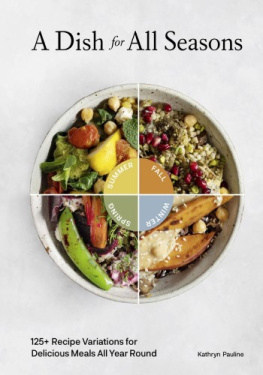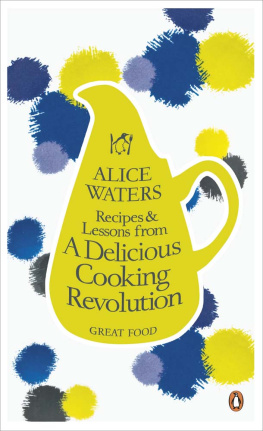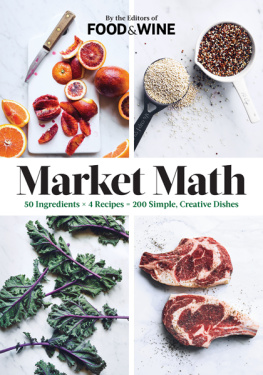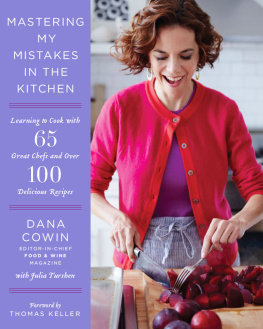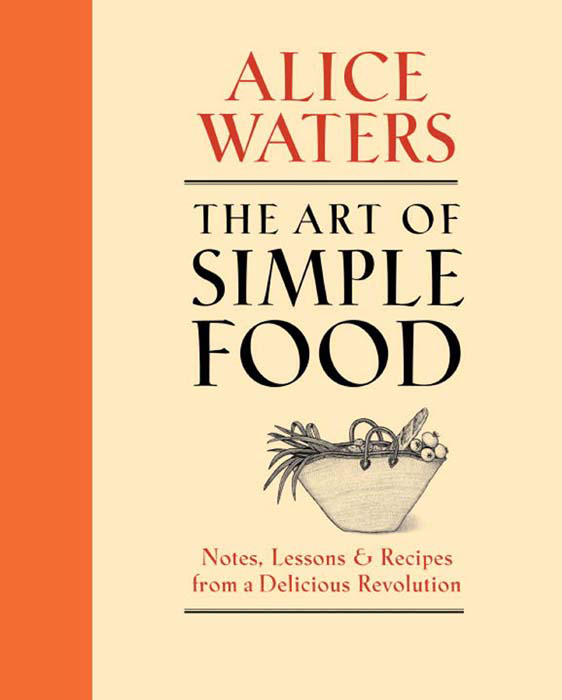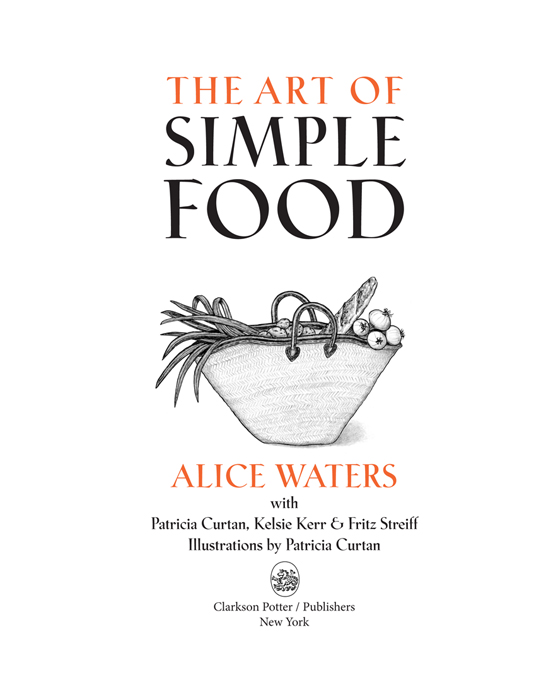Copyright 2007 by Alice Waters
Illustrations 2007 by Patricia Curtan
All rights reserved.
Published in the United States by Clarkson Potter/Publishers, an imprint of the Crown Publishing Group, a division of Random House, Inc., New York.
www.crownpublishing.com
www.clarksonpotter.com
Clarkson N. Potter is a trademark and Potter and colophon are registered trademarks of Random House, Inc.
Library of Congress Cataloging-in-Publication Data is available upon request.
eISBN: 978-0-307-88558-6
v3.1
Also from Alice Waters and Chez Panisse
Chez Panisse Fruit
Chez Panisse Caf Cookbook
Chez Panisse Vegetables
Fanny at Chez Panisse
Chez Panisse Cooking
Chez Panisse Desserts
Chez Panisse Pasta, Pizza, and Calzone
Chez Panisse Menu Cookbook
For
Ella, Xavier, Fanny, Rose, and Zac
with love


Lessons & Foundation Recipes
Desserts

M Y DELICIOUS REVOLUTION began when, young and nave, I started a restaurant and went looking for good-tasting food to cook. I was trying to find ingredients like the ones I had loved when I was a student in France: simple things like lettuces, and green beans, and bread. I was searching for flavor, not philosophy, but what I found was that the people who were growing the tastiest food were organic farmers in my own backyard, small farmers and ranchers within a radius of a hundred miles or so of the restaurant who were planting heirloom varieties of fruits and vegetables and harvesting them at their peak. What was revolutionary about this was being able to buy directly from the source and not being limited to what I could find at the supermarket.
When you have the best and tastiest ingredients, you can cook very simply and the food will be extraordinary because it tastes like what it is. This is what weve learned at Chez Panisse after years of sourcing, preparing, and tasting food. Food tastes naturally delicious when it has been grown with care, harvested at the right moment, and brought to us immediately, direct from the producer. But food like this is not just the privilege of a restaurant like ours. The same local producers sell the same fresh food down the street, at the farmers market. And anyone can buy it.
When I started shopping at farmers markets, one of the best things about the experience was meeting farmers and learning from themand influencing them, too, by asking if they could grow vegetables and fruits that had almost disappeared from commerce. After years of this weekly connection, I realized that I had become dependent on a family of friendsand they were dependent on me. By choosing to buy food grown locally and sustainably, in ways that are healthy and humane, I had woven myself into a community that cares about the same things. As a community, we share not only a commitment to protect our natural resources, but an appreciation for the value of food itself, a love for its taste and beauty and the deep pleasure it can bring by connecting us to time and place, the seasons, and the cycle of nature.
Good cooking is no mystery. You dont need years of culinary training, or rare and costly foodstuffs, or an encyclopedic knowledge of world cuisines. You need only your own five senses. You need good ingredients, too, of course, but in order to choose and prepare them, you need to experience them fully. Its the many dimensions of sensual experience that make cooking so satisfying. You never stop learning.
This book is for everyone who wants to learn to cook, or to become a better cook. The first part is a series of chapters that review the basics of simple food, beginning with how to choose fresh ingredients and stock a pantry and how to decide what to cook. The chapters that follow focus on essential cooking techniques, with detailed explanations of the whys and wherefores and simple model recipes. By cooking your way through these lessons, tasting and learning from your successes (and your mistakes), you will get to know some fundamental techniques by heart and you wont have to look them up again. This will enable you to cook with ease and confidence, inspired by recipesrather than being ruled by themand free to enjoy the sheer pleasure of preparing and sharing simple food with your friends and family. In the second half of the book you will find more recipes in the same format, chosen because they are easily made once you are familiar with the techniques set forth in the lessons.
Im convinced that the underlying principles of good cooking are the same everywhere. These principles have less to do with recipes and techniques than they do with gathering good ingredients, which for me is the essence of cooking. Whenever I give cooking demonstrations, I put everything I will be cooking on display, and the audience is always wide-eyed and amazed at how beautiful it all is. They ask, Where did you get that?!, and I answer, At your farmers marketand you can get it, too! After all these years, Ive distilled just about everything I know about cooking down to thatand a few other simple propositions. Ive made a list of them here. I believe that if you follow them your cooking will be transformed. They are the principles of a delicious revolution, one that can reconnect our families and communities with the most basic human values, provide the deepest delight for all our senses, and assure our well-being for a lifetime.
Eat locally and sustainably.
Learn where your food comes from and how it is produced. Seek out a diverse variety of vegetables and fruits from small, local producers who take care of the land. Buy eggs, meat, and fish from producers whose practices are organic, humane, and environmentally sound.
Eat seasonally.
Choose food in season. Even where the growing season is short, organic gardening and farming can extend it: greens can be grown in cold frames and greenhouses, and there are always local foods that can be stored, dried, and canned for the winter months. Eating seasonally inspires your menus, gives you a sense of time and place, and rewards you with the most flavorful food.
Shop at farmers markets.
Farmers markets create communities that value diversity, honesty, seasonality, locality, sustainability, and beauty. Get to know the people who grow your food. Think of yourself as a partner with the farmers, learning from them and working with them.



